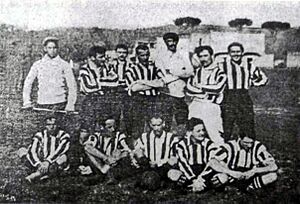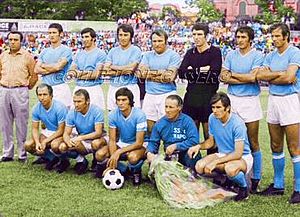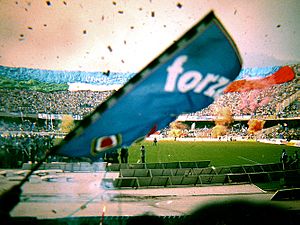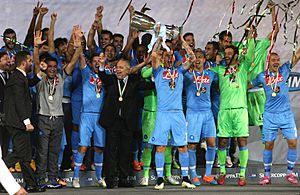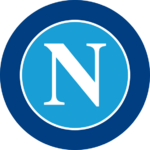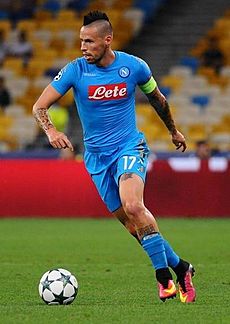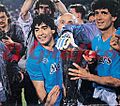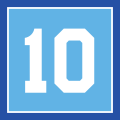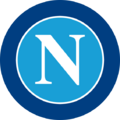SSC Napoli facts for kids
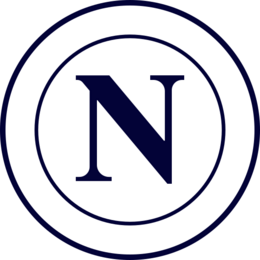 |
||||
| Full name | Società Sportiva Calcio Napoli S.p.A. | |||
|---|---|---|---|---|
| Nickname(s) | Gli Azzurri (The Blues) I Partenopei (The Parthenopeans) I Ciucciarelli (The Little Donkeys) |
|||
| Short name | SSC Napoli | |||
| Founded | 25 August 1926, as Associazione Calcio Napoli 6 September 2004, as Napoli Soccer then SSC Napoli |
|||
| Ground | Stadio Diego Armando Maradona | |||
| Capacity | 54,725 | |||
| Owner | Filmauro S.r.l. | |||
| President | Aurelio De Laurentiis | |||
| Head coach | Antonio Conte | |||
| League | Serie A | |||
| 2018–19 | Serie A, 2nd of 20 | |||
|
||||
Società Sportiva Calcio Napoli, often called SSC Napoli or just Napoli, is a professional football club from Naples, Italy. They play in Serie A, which is Italy's top football league. Napoli is one of the most successful teams in Italy. They have won the league title four times, the Coppa Italia six times, the Supercoppa Italiana twice, and the UEFA Cup once. Napoli are the current champions of Italy, having won their second Serie A title in the last three seasons.
The club started in 1926 as Associazione Calcio Napoli. This happened when two older clubs, US Internazionale Napoli and Naples Foot-Ball Club, joined together. Napoli did not win a major trophy until 1962, when they won the Coppa Italia. The team became much more successful in the 1970s and 1980s. They won the Coppa Italia again in 1976. Their biggest success came after Diego Maradona joined in 1984. With Maradona, Napoli won their first two league titles in 1987 and 1990. During his seven years, they also won the Coppa Italia in 1987, the Supercoppa Italiana in 1990, and their only European trophy, the UEFA Cup, in 1989.
After Maradona left in 1991, Napoli faced money problems. They were relegated to lower leagues and even went bankrupt in 2004. Film producer Aurelio De Laurentiis then re-started the club as Napoli Soccer. Three years later, Napoli returned to Serie A. Since then, they have been one of Italy's top clubs. They won the Coppa Italia three more times (2012, 2014, and 2020), the Supercoppa Italiana in 2014, and two more Serie A titles (2023 and 2025).
Napoli has the fourth-largest fan base in Italy. In 2018, the club was valued at $379 million, making it the fifth most valuable club in Italy.
Since 1959, Napoli has played its home games at the Stadio San Paolo. This stadium was renamed Stadio Diego Armando Maradona in 2020, after the famous player passed away. Napoli's home kit is usually sky blue shirts, white shorts, and sky blue socks. Their away kit is white shirts, with white or sky blue shorts and socks. These colors come from the original clubs that merged to form Napoli. Napoli has strong rivalries with teams like Juventus, Roma, Internazionale, AC Milan, and Salernitana. The club's anthem is "Napoli," a popular song by Nino D'Angelo.
Contents
Club History
How Napoli Began
Even though Napoli officially started in 1926, its history goes back to 1905. That year, an English sailor named William Poths and his friend Hector M. Bayon founded the "Naples Foot-Ball & Croquet Club." Amedeo Salsi was the first president. The team's first uniform was a striped sky blue and navy blue shirt with black shorts. Their first game was a 3–2 win against an English ship's crew.
In the early days, the Italian Football Championship was mostly for northern clubs. So, southern clubs like Naples FBC played against sailors or in special cups. Naples FBC won the Lipton Challenge Cup three times against Palermo FBC. In 1911, the foreign players left to form Internazionale Napoli. Both clubs then played in the Italian Championship.
Because of money problems, the two rival clubs joined together on October 2, 1922. They became "Foot-Ball Club Internazionale-Naples," or "FBC Internaples." The new club's uniforms combined the sky blue from Naples FBC and the white shorts from Internazionale Napoli.
FBC Internaples and a New Name
Many people saw Internaples as a continuation of Internazionale Napoli. The club played at Internazionale Napoli's stadium and kept their nickname, Gli Azzurri (The Blues). Internaples was also called I Puledri (the foals), because the horse is a symbol of Naples.
Internaples played in the top league, the Prima Divisione Lega Sud. They reached the semi-finals in their first two seasons and the finals in 1925–26. This earned them a spot in the new national league, the Divisione Nazionale.
On August 25, 1926, under President Giorgio Ascarelli, Internaples changed its name to Associazione Calcio Napoli. The team also moved to a new stadium. After a tough start, Napoli began to improve. A player named Attila Sallustro became a fan favorite, scoring many goals.
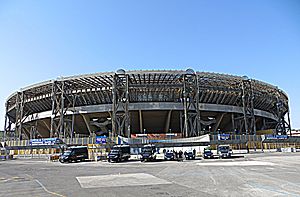
Napoli entered the Serie A era with William Garbutt as manager. Under him, the club often finished in the top half of the league, including two third-place finishes in 1933 and 1934. However, before World War II, Napoli's performance declined, and they were relegated to Serie B in 1942.
First Trophies and a New Era
After the war, football restarted. Napoli won their division in 1946 and were promoted back to Serie A. They were relegated again but quickly returned to the top league in 1950. In 1959, Napoli moved to their new home, Stadio San Paolo.
Despite ups and downs in the league, Napoli won their first major trophy in 1962. They beat SPAL to win the Coppa Italia. This made Napoli the first team to win the Coppa while in Serie B. They were promoted to Serie A that same season.
On June 25, 1964, the club changed its name to Società Sportiva Calcio Napoli. They were promoted back to Serie A in 1965. Under manager Bruno Pesaola, they won the Coppa delle Alpi and consistently finished in the top five in Serie A. Napoli almost won the league in 1968, finishing second. Famous players from this time included Dino Zoff and José Altafini.
Steady Success and More Cups
Napoli continued to do well in the 1970s, finishing third in 1971 and 1974. This allowed them to play in the early UEFA Cup competitions. In 1975, they reached the third round. That same season, Napoli finished second in Serie A, just behind Juventus.
The club won their second Coppa Italia trophy in 1976, beating Hellas Verona 4–0 in the final. They also won the 1976 Anglo-Italian League Cup. In the UEFA Cup Winners' Cup for 1977, Napoli reached the semi-finals. Napoli remained a strong team in the late 1970s and early 1980s.
The Maradona Era: A Golden Age
Napoli made history on June 30, 1984, by signing Diego Maradona from Barcelona for a world-record fee. The team was rebuilt with players like Ciro Ferrara and Fernando De Napoli. Napoli slowly climbed the league table, finishing third in 1986.
The 1986–87 season was unforgettable for Napoli. With Maradona, Bruno Giordano, and Careca (nicknamed MaGiCa), Napoli became only the third Italian team to win "the double." They won the Serie A title and then beat Atalanta 4–0 to lift the Coppa Italia.
This victory was huge for Southern Italy, as no team from the south had ever won the league before. Maradona became a hero in Naples, loved by everyone.
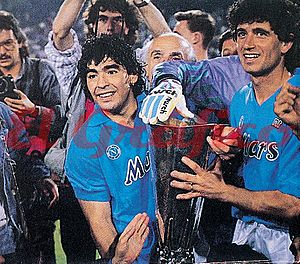
Napoli finished second in Serie A the next season. In 1989, they won their first major European trophy, the UEFA Cup. They defeated teams like Juventus and Bayern Munich before beating VfB Stuttgart 5–4 in the final.
Napoli won their second Serie A title in 1990. However, after the 1990 World Cup, Maradona faced a ban due to a failed drug test. He never played for Napoli again. Despite this, the club still won the Supercoppa Italiana that year, beating Juventus 5–1. This was their last major trophy for 22 years.
Decline and Rebirth
After Maradona left, Napoli's performance declined, and they faced financial difficulties. Key players like Gianfranco Zola and Careca left. Napoli reached the Coppa Italia final in 1997 but lost. They were relegated to Serie B at the end of 1998.
The club returned to Serie A in 2000 but was relegated again the next season. By August 2004, Napoli went bankrupt. To keep football alive in the city, film producer Aurelio De Laurentiis re-founded the club as Napoli Soccer. They were placed in Serie C1, the third division.
Even in a lower league, Napoli had huge crowds, breaking attendance records for Serie C. In 2006, they were promoted to Serie B. De Laurentiis then brought back the club's original name, Società Sportiva Calcio Napoli. After just one season in Serie B, they were promoted back to Serie A in 2007.
Return to Glory
Under manager Walter Mazzarri, Napoli finished sixth in 2010, qualifying for the 2010–11 UEFA Europa League. They finished third in 2011, earning a spot in the Champions League.
In 2012, Napoli won the Coppa Italia for the fourth time, beating Juventus. This was their first cup win in 25 years. They reached the Champions League round of 16 that season. In 2013, Napoli finished second in Serie A, their best result since 1990. Edinson Cavani was the league's top scorer with 29 goals.
Rafael Benítez became manager in 2013. Napoli won their fifth Coppa Italia in 2014, beating Fiorentina. They also won the Supercoppa Italiana that year. After Benítez left, Maurizio Sarri took over. In 2016, Napoli finished second in Serie A with 82 points.
In 2018, Napoli challenged for the league title all season, earning a club record 91 points, but Juventus ultimately won. Marek Hamšík became Napoli's all-time leading scorer that year. Carlo Ancelotti then became manager, followed by Gennaro Gattuso. In June 2020, Dries Mertens became Napoli's all-time top scorer. Napoli went on to win the 2019–20 Coppa Italia by beating Juventus in a penalty shoot-out.
In December 2020, the Stadio San Paolo was renamed Stadio Diego Armando Maradona to honor the club legend. In 2022, Luciano Spalletti became head coach and led the team to third place, securing a Champions League spot.
Scudetto Returns!
In the 2022–23 season, Napoli won the Serie A title for the first time since 1990, and their third title overall! They clinched it with a 1–1 draw against Udinese on May 4, 2023. In the Champions League, Spalletti led them to the quarter-finals for the first time in their history.
The 2023–24 season was tough, with three different coaches. Napoli finished 10th in the league. However, they made it past the group stage in the 2023–24 UEFA Champions League before being knocked out by Barcelona.
For the 2024–25 season, the club signed Antonio Conte to try and win the title again. After a tough start, the team quickly improved. With new players like Scott McTominay and Romelu Lukaku, Napoli played strongly all season. They won their fourth league title on May 23, winning 2–0 against Cagliari. This was their second title in three years, showing Napoli is a top team in Serie A.
Club Staff
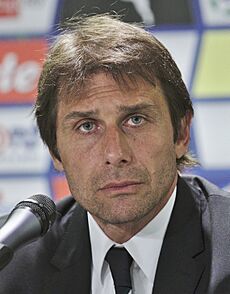
| Position | Staff |
|---|---|
| Head Coach | |
| Assistant Head Coach | |
| Goalkeeping Coach | |
| Technical Coach | |
| Athletic Trainer | |
| Match Analyst | |
| First-Team Doctor | |
| Masseur | |
| Nutritionist | |
| Physiotherapist | |
| Medical Director Physiotherapy | |
| Sporting Director | |
| Sports Coordinator | |
| Head of Scouting | |
| Academy Manager | |
| Kit Manager |
Club Presidents
Here is a list of Napoli's presidents since 1926:
|
|
|
Team Managers
Napoli has had many managers since 1926. Here are some of them:
|
|
Players
First-Team Squad
|
|
Other Players Under Contract
|
|
Out on Loan
|
Retired Numbers
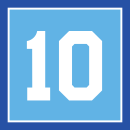
Napoli retired the number 10 jersey in 2000 to honor club legend Diego Maradona, who played for the team from 1984 to 1991. This means no other player can wear that number.
However, for a short time between 2004 and 2006, when Napoli was in the third division (Serie C1), the number 10 was used again. This was because the league rules at the time required players to wear numbers 1 to 11. The last player to wear and score goals with the number 10 shirt in an official match was Mariano Bogliacino in 2006.
Club Culture
Colors, Badge, and Nicknames
Naples is a city by the sea, so the club's colors have always been inspired by the blue waters of the Gulf of Naples. When the club was first called Naples FBC, they used two shades of blue. But since the 1920s, they have used a single shade of blue, often a sky blue. Because of this, Napoli shares the nickname "Azzurri" (The Blues) with the Italian national team.
Napoli's home uniform is usually sky blue shirts with white shorts. Their away uniform is white shirts with either white or blue shorts.
One of Napoli's nicknames is "I ciucci", which means "the donkeys" in the Neapolitan language. This name was given after a poor performance in the 1926–27 season. It was meant to be an insult, as Naples' symbol is a proud black horse. But the club adopted the donkey as a mascot, calling it "'O Ciuccio".
Napoli's first badge had a horse on top of a football. The current club badge features a large "N" inside a circle. This design comes from an older club, Internazionale Napoli. Napoli has changed the badge slightly over the years, sometimes adding the club's name around the "N." The "N" is usually white, but it was sometimes gold before 1980.
"Partenopei" is another popular nickname for the club and people from Naples. It comes from an old Greek story about a siren named Parthenope. In the story, she tried to charm Odysseus with her singing. When he resisted, she was so sad that she drowned herself, and her body washed up on the shore of Naples.
Supporters and Rivalries
Fan Support
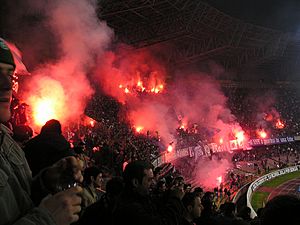
Napoli is the fourth most supported football club in Italy. About 13% of Italian football fans support the club. Napoli's fans are not just in Italy; in 2018, the club said they had over 35 million supporters worldwide.
Napoli's main fan groups are called Fedayn EAM 1979, Ultras Napoli, Fossato Flegreo, Secco Vive, Mastiffs, Brigata Carolina, Teste Matte, Sud1996, Nuova Guardia, Vecchi Lions, and Masseria.
Napoli fans are known for cheering so loudly that it has registered as small earthquakes on special equipment at the University of Naples Federico II. A famous player once said that when he heard 80,000 Napoli fans whistling, his legs were shaking! He realized that for these people, Napoli is not just a team, but a deep love.
Rivalries
Unlike other big Italian cities, Naples only has one major football club, so there isn't a local derby in the same way.
Napoli's most intense rivalry is with Juventus. There is also a strong rivalry with Roma. While Napoli and Roma fans used to be friends, especially in the 1970s and 80s (known as the Derby del Sole or Derby of the Sun), this friendship ended in 1987. The rivalry became more intense after a tragic incident in 2014.
Since Napoli is one of the most important southern Italian teams, they have many rivalries with northern teams. These include Milan, Internazionale, Atalanta BC, and Hellas Verona. Napoli fans also have a strong rivalry with Lazio. They also play the Derby del Mezzogiorno (Derby of Southern Italy) against Bari and the Derby Bourbon against Foggia.
Friendships
Napoli has a "friendly rivalry" with Palermo, known as the Derby delle Due Sicilie (Derby of the Two Sicilies). This name refers to the historical link between their regions. Another friendly rivalry is with Catania, called the Derby del Vulcano (Volcano Derby), because of Mount Vesuvius near Naples and Mount Etna near Catania.
Napoli also has friendships with teams outside Italy, such as Borussia Dortmund, Celtic, Lokomotiv Plovdiv, Paris Saint-Germain, and Red Star Belgrade.
Club Honours
| Type | Competition | Titles | Seasons |
|---|---|---|---|
| Domestic | Serie A | 4 | 1986–87, 1989–90, 2022–23, 2024–25 |
| Coppa Italia | 6 | 1961–62, 1975–76, 1986–87, 2011–12, 2013–14, 2019–20 | |
| Supercoppa Italiana | 2 | 1990, 2014 | |
| Continental | UEFA Cup | 1 | 1988–89 |
Other Titles
- Coppa delle Alpi
- Winners: (1) 1966
- Anglo-Italian League Cup
- Winners: (1) 1976
- Serie B
- Winners: (2) 1945–46, 1949–50
- Serie C1
- Winners: (1) 2005–06 (Group B)
Records and Statistics
Marek Hamšík has played the most games for Napoli, with 520 appearances. He also holds the record for most league appearances, playing 408 games over 12 years.
The all-time leading goal scorer for Napoli is Dries Mertens, with 148 goals. He also holds the record for most league goals, with 113.
Diego Maradona was the top scorer in Serie A in the 1987–88 season with 15 goals. This achievement was also reached by Edinson Cavani in 2012–13, Gonzalo Higuaín in 2015–16, and Victor Osimhen in 2022–23.
The record for most goals in a single league season belongs to Gonzalo Higuaín, who scored 36 goals in the 2015–16 Serie A.
Napoli's biggest victory was 8–1 against Pro Patria in the 1955–56 Serie A season. Their heaviest league defeat was 11–0 against Torino in the 1927–28 season.
On July 26, 2016, Gonzalo Higuaín's transfer to Juventus for €90 million was one of the most expensive football transfers ever at the time.
On July 31, 2020, Napoli signed Victor Osimhen from Lille for €70 million, making him Napoli's most expensive signing in history.
Images for kids
-
Napoli moved to the new Stadio San Paolo in 1959, where they have played since.
-
Napoli at the start of the 1970s with Dino Zoff, José Altafini, and others
-
Diego Maradona celebrating with the UEFA Cup trophy after beating VfB Stuttgart, May 1989
-
Antonio Conte is the current head coach of the club
-
Jersey number 10, retired in 2000 as tribute to Diego Maradona
-
Napoli ultras at Stadio San Paolo
See also
 In Spanish: Società Sportiva Calcio Napoli para niños
In Spanish: Società Sportiva Calcio Napoli para niños


